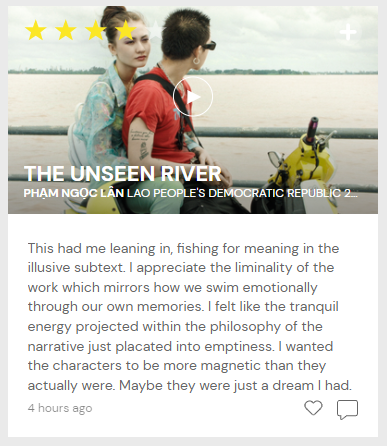457 posts
------This 20 Minute Film Is Very Transient Of Its Own Context, Opening Itself To Exploration Beyond

------”This 20 minute film is very transient of its own context, opening itself to exploration beyond cultural nuance. There was a moment where the film really allowed me to indulge in it’s meditative quality. I could almost say that I participated my emotion and attention more than the character itself.”
More Posts from Yoswenyo

------“I thought this concept was pretty enticing, given the stakes. It really expressed how love grounds people’s existence. Wish it had more time to flesh out the characters.”
But how I was astonished, as I looked at a white wall through the prism, that it stayed white! That only where it came upon some darkened area, it showed some colour, then at last, around the window sill all the colours shone... It didn't take long before I knew here was something significant about colour to be brought forth, and I spoke as through an instinct out loud, that the Newtonian teachings were false.
— Goethe[4]
The theory we set up against this begins with colourless light, and avails itself of outward conditions, to produce coloured phenomena; but it concedes worth and dignity to these conditions. It does not arrogate to itself developing colours from the light, but rather seeks to prove by numberless cases that colour is produced by light as well as by what stands against it.
— Goethe[11]

Influence on Latin American flags
During a party in Weimar in the winter of 1785, Goethe had a late-night conversation with the South American revolutionary Francisco de Miranda. In a letter written to Count Semyon Romanovich Vorontsov (1792), Miranda recounted how Goethe, fascinated with his exploits throughout the Americas and Europe, told him, "Your destiny is to create in your land a place where primary colours are not distorted." He proceeded to clarify what he meant:
First he explained to me the way the iris transforms the light into the three primary colours... then he said, "Why yellow is the most warm, noble and closest to the bright light; why Blue is that mix of excitement and serenity, so far that it evokes the shadows; and why Red is the exaltation of Yellow and Blue, the synthesis, the vanishing of the bright light into the shadows".[37]
Goethe discovered that producing images by passing inverse optical contrasts through a prism always results in isomorphic, complementary spectra. Against the background of the representation he had found in Newton’s Opticks, this was an unexpected discovery. Experimental developments by physicist Matthias Rang have demonstrated Goethe's discovery of complementarity as a symmetric property of spectral phenomena.[43]
"Goethe's critique of Newton was not an attack on reason or science, though it has often been portrayed that way.. The critique maintained that Newton had mistaken mathematical imagining as the pure evidence of the senses.. Goethe tried to define the scientific function of imagination: to interrelate phenomena once they have been meticulously produced, described, and organized... Newton had introduced dogma.. into color science by claiming that color could be reduced to a function of rays." (Dennis L. Sepper, 2009)[45]
Goethe started out by accepting Newton's physical theory. He soon abandoned it... finding modification to be more in keeping with his own insights. One beneficial consequence of this was that he developed an awareness of the importance of the physiological aspect of colour perception, and was therefore able to demonstrate that Newton's theory of light and colours is too simplistic; that there is more to colour than variable refrangibility.

The real revelation of the writer (as of the artist) comes in a far subtler way than by autobiography; and comes despite all effort to elude it; ... For what the writer does communicate is his temperament, his organic personality, with its preferences and aversions, its pace and rhythm and impact and balance, its swiftness or languor ... and this he does equally whether he be rehearsing veraciously his own concerns or inventing someone else’s.
Shakespeares Imagery And What It Tells Us (1923)
by Spurgeon, Caroline. F.
In any analysis arrived of the quality and characteristics of a writer’s senses, it is possible in some degree to separate and estimate his senses of touch, smell, hearing and taste, but his visual sense is so all-embracing — for it is indeed the gateway by which so large a portion of life reaches the poet;
Shakespeares Imagery And What It Tells Us (1923)
by Spurgeon, Caroline. F.
Metaphor is essentially an expression of an inward situation in outward and concrete terms. Broadly speaking, it can be said that, while metaphor reflects those inward events of which the poet is clearly conscious, and involves a conscious mode of thought and manipulation of words, a symbol reflects the stirring of massive intuitions inaccessibl. to reason. From a study of the imagery, therefore, may follow a discovery of the symbolism.
The Imagery of Thomas De Quincy's Impassioned Prose - Dwyer (1965)
